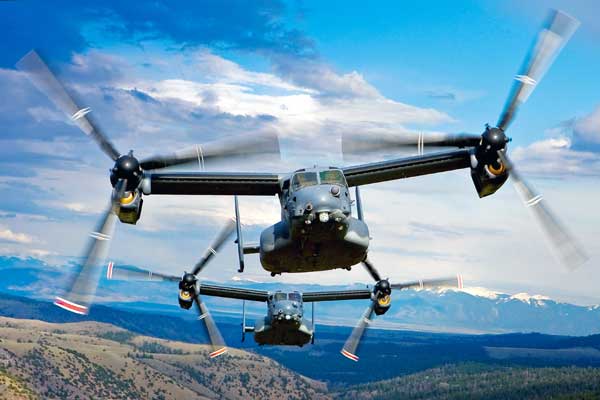 There was a time when people used to say – sky is the limit. Not anymore. The skies of tomorrow promise to be abuzz with new breeds of aircraft, reshaping the landscape of military aviation.
There was a time when people used to say – sky is the limit. Not anymore. The skies of tomorrow promise to be abuzz with new breeds of aircraft, reshaping the landscape of military aviation.
While armed forces continue to rely upon conventional aircraft to meet their operational requirements, the point to be noted is that conventional aircraft have a number of tactical, logistical and strategic limitations which cannot be overlooked.
Conventional aircraft require long, paved runways and cannot operate where runways are absent or damaged, or during adverse weather conditions like fog, strong winds, or snow which can hamper their performance and sometimes grounding them entirely. These are just a few reasons that limit their operational flexibility, especially in remote areas or conflict zones without developed infrastructure. This apart conventional rotary wing aircrafts are slow, less maneuverable hence susceptible to ground-based air defence during takeoff and landing.
This is precisely why we’ve seen the development of a variety of other aerial technology to complement and, in some cases, even surpass them. Here are some of the key examples:
While still in the early stages of development, eVTOL could revolutionize military logistics by efficiently transporting supplies and equipment to remote locations, even in challenging terrain. Their ability to land in tight spaces and take off vertically makes them ideal for quickly evacuating wounded soldiers from the battlefield. eVTOLs equipped with advanced sensors, could also provide persistent surveillance over wide areas without needing to land for refueling.
3. Unmanned Aerial Vehicles (UAVs): Drones of various sizes and capabilities have become crucial for modern warfare. They offer prolonged surveillance, intelligence gathering, and even strike capabilities without risking human lives. Their ability to operate for extended periods and reach areas otherwise inaccessible to manned aircraft make them invaluable assets.
5. Space Assets: Military satellites provide crucial communication, navigation, and intelligence gathering capabilities across the globe. While technically not “aircraft” in the traditional sense, they play a vital role in modern warfare by expanding situational awareness and enabling precise targeting.
While conventional aircraft still hold their place in modern militaries, in this article we shall focus mainly on how electric vertical takeoff and landing (eVTOL) and short takeoff and vertical landing (sVTOL) will contribute towards greater flexibility, adaptability, and effectiveness of airpower in contemporary conflicts.
Interestingly while both offer vertical lift capabilities, they differ significantly in their approach. This leads to the biggest question – which will reign supreme in the future of military flight?
eVTOL: The Electric Revolution Takes Flight
eVTOL aircraft represent a paradigm shift, replacing traditional combustion engines with electric motors powered by batteries or hydrogen fuel cells. This translates to several advantages:
-
-
- Reduced Noise Pollution: eVTOL’s quiet operation minimizes noise signature, a crucial advantage for covert missions and urban deployments.
- Minimal Emissions: Electric propulsion significantly reduces greenhouse gas emissions, aligning with growing environmental concerns.
- Lower Operational Cost: Electric power promises lower fuel costs and less complex maintenance compared to traditional engines.
- Increased Agility and Maneuverability: The distributed nature of electric motors offers unique control possibilities, enhancing agility and maneuverability.
-
However, eVTOL faces challenges:
-
-
- Limited Range and Payload: Current battery technology limits range and payload capacity, restricting long-distance missions and heavy cargo transportation.
- Recharging Infrastructure: Establishing a robust network of charging stations for a widespread eVTOL fleet poses a significant logistical hurdle.
- Weather Dependence: Electric propulsion systems are susceptible to extreme weather conditions, impacting operational reliability.
-
sVTOL: The Legacy of Combustion Engines Evolves
sVTOL, on the other hand, leverages traditional combustion engines with vectored thrust technology, allowing for vertical take-off and landing on short runways. Its strengths include:
-
-
- Proven Reliability: Decades of experience with combustion engines ensure reliable performance in diverse environments.
- Greater Range and Payload: Existing technology offers superior range and payload capacity compared to current eVTOL models, enabling longer missions and heavier cargo transport.
- Existing Infrastructure: Utilizing established fuel infrastructure eliminates the need for new charging networks.
-
However, sVTOL also has drawbacks:
-
-
- High Noise Signature: The use of combustion engines generates significant noise, limiting covert operations and potentially impacting urban deployments.
- Significant Emissions: Combustion engines contribute to greenhouse gas emissions, raising environmental concerns.
- Higher Operational Cost: Fuel costs and complex engine maintenance contribute to higher operational expenses compared to eVTOL.
-
Key differences:
The main difference between eVTOL and sVTOL lies in their propulsion systems. eVTOLs rely on electric motors, while sVTOLs use conventional jet engines or turboprop engines. This difference leads to variations in their performance characteristics:
Range: sVTOLs generally have longer range than eVTOLs due to the higher energy density of jet fuel compared to batteries.
Speed: sVTOLs can achieve higher speeds than eVTOLs, although advancements in electric propulsion are narrowing this gap.
Payload: sVTOLs can typically carry heavier payloads than eVTOLs, but this depends on the specific aircraft design.
Noise: eVTOLs are significantly quieter than sVTOLs, offering a tactical advantage in certain situations.
The Battlefield Crossroads: Choosing the Right Tool
The choice between eVTOL and sVTOL depends heavily on the specific mission requirements. For short-range, low-noise reconnaissance or medical evacuation missions, the quiet agility of eVTOL might be ideal. On the other hand, long-range troop or heavy equipment transport might favor the established capabilities and larger payload capacity of sVTOL.
Military forces are actively exploring both options. The US Army’s Future Vertical Lift (FVL) program aims to develop next-generation vertical lift platforms, with both eVTOL and sVTOL contenders participating. Similarly, the Agility Prime program investigates the integration of emerging technologies, including eVTOL, into military operations.
Beyond the Binary: Hybrid Solutions and the Future
The future of military aviation might not be a winner-takes-all scenario. Hybrid solutions combining elements of both technologies are a possibility. For instance, eVTOL technology could be integrated into sVTOL aircraft for quieter short-range operations while leveraging the longer range and payload capabilities of traditional engines.
Furthermore, technological advancements are constantly evolving. Battery technology improvements could enhance eVTOL range and payload, while sustainable fuels could address emissions concerns for sVTOL. These advancements will blur the lines between the two technologies, leading to a more nuanced landscape in the future.
Lessons from the Ukraine war suggest that low-flying slow speed helicopters have been easy targets for anti-aircraft guns and missiles. Just like casualties in armoured vehicles and tanks in the initial stages of the Ukraine war have not rendered tanks as vestigial weapons of war, the helicopter too cannot be said to have become redundant in a future war situation.
Conclusion: A Collaborative Climb
As the technology matures and these hurdles are addressed, we can expect to see eVTOLs and sVTOLs playing an increasingly important role in future military operations.
Ultimately, the future of military aviation will be shaped by a collaborative approach, leveraging the strengths of both eVTOLand sVTOL depending on the mission needs. Continued innovation and partnership between the military and aerospace industry will be key in unlocking the full potential of these transformative technologies, ensuring the skies of tomorrow are safe, efficient, and adaptable to the ever-changing demands of warfare.




